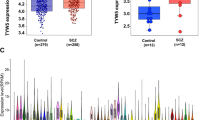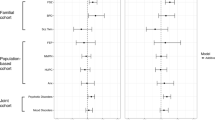Abstract
Formal thought disorder (FTD), or disorganized speech, is one of the central signs of schizophrenia; however, little is known about the etiology of FTD. To identify new genetic loci associated with FTD, we conducted the first genome-wide association meta-analysis of two datasets of 835 cases of FTD and 2,694 controls with 729,454 single-nucleotide polymorphisms (SNPs). Logistic regression analysis of FTD as a binary trait, adjusted for age and sex, was performed using PLINK. For meta-analysis of two datasets, the fixed-effect model in PLINK was applied. Through meta-analysis we identified 61 SNPs associated with FTD with p < 10−4. The most significant association with FTD was observed with rs1783925 (p = 4.4 × 10−7) within PKNOX2 gene at 11q24.2 while the second interesting locus was rs2277644 (p = 1.18 × 10−5) within MYH13 at 17p13. Haplotype analyses of PKNOX2 and MYH13 loci further supported the associations with FTD. The third locus was PHF2 at 9q22.31 (the top SNP was rs12238738 with p = 2.08 × 10−5) while the fourth locus was GPC6 at 13q32 (the top SNP was rs17196161 with p = 3.12 × 10−5). In conclusion, we identified four new loci (PKNOX2, MYH13, PHF2, and GPC6) associated with FTD. These findings offer the potential for new insights into the pathogenesis of FTD and schizophrenia.

Similar content being viewed by others
References
Barrett JC, Fry B, Maller J, Daly MJ (2005) Haploview: analysis and visualization of LD and haplotype maps. Bioinformatics 21:263–265
Berenbaum H, Oltmanns TF, Gottesman II (1985) Formal thought disorder in schizophrenics and their twins. J Abnorm Psychol 94:3–16
Bierut LJ, Agrawal A, Bucholz KK et al (2010) A genome-wide association study of alcohol dependence. Proc Natl Acad Sci USA 107:5082–5087
Borenstein M, Hedges LV, Higgins JPT, Rothstein HR (2009) Introduction to meta-analysis (statistics in practice). Wiley, New York
Calboli FC, Tozzi F, Galwey NW et al (2010) Genome-wide association study of neuroticism in a population-based sample. PLoS One 5:e11504
Campos-Xavier AB, Martinet D, Bateman J et al (2009) Mutations in the heparan-sulfate proteoglycan glypican 6 (GPC6) impair endochondral ossification and cause recessive omodysplasia. Am J Hum Genet 84:760–770
Cannon TD, Kaprio J, Lonnqvist J, Huttunen M, Koskenvuo M (1998) The genetic epidemiology of schizophrenia in a Finnish twin cohort. A population-based modeling study. Arch Gen Psychiatry 55:67–74
Cascella NG, Schretlen DJ, Sawa A (2009) Schizophrenia and epilepsy: is there a shared susceptibility? Neurosci Res 63:227–235
Chen X, Cho K, Singer BH, Zhang H (2011) The nuclear transcription factor PKNOX2 is a candidate gene for substance dependence in European-origin women. PLoS One 6:e16002
Detera-Wadleigh SD, McMahon FJ (2006) G72/G30 in schizophrenia and bipolar disorder: review and meta-analysis. Biol Psychiatry 60:106–114
Fognani C, Kilstrup-Nielsen C, Berthelsen J, Ferretti E, Zappavigna V, Blasi F (2002) Characterization of PREP2, a paralog of PREP1, which defines a novel sub-family of the MEINOX TALE homeodomain transcription factors. Nucleic Acids Res 30:2043–2051
Gejman PV, Sanders AR, Duan J (2010) The role of genetics in the etiology of schizophrenia. Psychiatr Clin North Am 33:35–66
Guerra R, Goldstein DR (eds) (2010) Meta-analysis and combining information in genetics and genomics. Chapman and Hall/CRC, London
Hamshere ML, Green EK, Jones IR et al (2009) Genetic utility of broadly defined bipolar schizoaffective disorder as a diagnostic concept. Br J Psychiatry 195:23–29
Hasenpusch-Theil K, Chadwick BP, Theil T, Heath SK, Wilkinson DG, Frischauf AM (1999) PHF2, a novel PHD finger gene located on human chromosome 9q22. Mamm Genome 10:294–298
Hodgkinson CA, Goldman D, Ducci F et al (2007) The FEZ1 gene shows no association to schizophrenia in Caucasian or African American populations. Neuropsychopharmacology 32:190–196
Imoto I, Sonoda I, Yuki Y, Inazawa J (2001) Identification and characterization of human PKNOX2, a novel homeobox-containing gene. Biochem Biophys Res Commun 287:270–276
Kang C, Drayna D (2011) Genetics of speech and language disorders. Annu Rev Genomics Hum Genet 12:145–164
Kerns JG, Berenbaum H (2002) Cognitive impairments associated with formal thought disorder in people with schizophrenia. J Abnorm Psychol 111:211–224
Kiefer M, Martens U, Weisbrod M, Hermle L, Spitzer M (2009) Increased unconscious semantic activation in schizophrenia patients with formal thought disorder. Schizophr Res 114:79–83
Laursen TM, Agerbo E, Pedersen CB (2009) Bipolar disorder, schizoaffective disorder, and schizophrenia overlap: a new comorbidity index. J Clin Psychiatry 70:1432–1438
Levy DL, Coleman MJ, Sung H et al (2010) the genetic basis of thought disorder and language and communication disturbances in schizophrenia. J Neurolinguistics 23:176
Lichtenstein P, Yip BH, Bjork C et al (2009) Common genetic determinants of schizophrenia and bipolar disorder in Swedish families: a population-based study. Lancet 373:234–239
Lucas CA, Rughani A, Hoh JFY (1995) Expression of extraocular myosin heavy chain in rabbit laryngeal muscle. J Muscle Res Cell Motil 16:368–378
Mowry BJ, Nancarrow DJ (2001) Molecular genetics of schizophrenia. Clin Exp Pharmacol Physiol 28:66–69
Mulligan MK, Ponomarev I, Hitzemann RJ et al (2006) Toward understanding the genetics of alcohol drinking through transcriptome meta-analysis. Proc Natl Acad Sci USA 103:6368–6373
Nieratschker V, Nothen MM, Rietschel M (2010) New genetic findings in schizophrenia: is there still room for the dopamine hypothesis of schizophrenia? Front Behav Neurosci 4:23
Owen MJ, Williams HJ, O'Donovan MC (2009) Schizophrenia genetics: advancing on two fronts. Curr Opin Genet Dev 19:266–270
Price AL, Patterson NJ, Plenge RM, Weinblatt ME, Shadick NA, Reich D (2006) Principal components analysis corrects for stratification in genome-wide association studies. Nat Genet 38:904–909
Purcell S, Neale B, Todd-Brown K et al (2007) PLINK: a tool set for whole-genome association and population-based linkage analyses. Am J Hum Genet 81:559–575
Rastogi A, Zai C, Likhodi O, Kennedy JL, Wong AH (2009) Genetic association and post-mortem brain mRNA analysis of DISC1 and related genes in schizophrenia. Schizophr Res 114:39–49
Sanders AR, Duan J, Levinson DF et al (2008) No significant association of 14 candidate genes with schizophrenia in a large European ancestry sample: implications for psychiatric genetics. Am J Psychiatry 165:497–506
Sanjuán J, Tolosa A, Colomer-Revuelta J, Ivorra-Martínez J, Llacer B, Jover M (2010) Genetic factors in the development of language. Rev Neurol 50(Suppl 3):S101–S106
Schjeide BM, McQueen MB, Mullin K et al (2009) Assessment of Alzheimer's disease case-control associations using family-based methods. Neurogenetics 10:19–25
Schumacher J, Laje G, Abou Jamra R (2009) The DISC locus and schizophrenia: evidence from an association study in a central European sample and from a meta-analysis across different European populations. Hum Mol Genet 18:2719–2727
Shi J, Badner JA, Gershon ES, Liu C (2008) Allelic association of G72/G30 with schizophrenia and bipolar disorder: a comprehensive meta-analysis. Schizophr Res 98:89–97
Shi J, Levinson DF, Duan J et al (2009) Common variants on chromosome 6p22.1 are associated with schizophrenia. Nature 460:753–757
Strik W, Dierks T, Hubl D, Horn H (2008) Hallucinations, thought disorders, and the language domain in schizophrenia. Clin EEG Neurosci 39:91–94
Tolosa A, Sanjuán J, Dagnall AM et al (2010) FOXP2 gene and language impairment in schizophrenia: association and epigenetic studies. BMC Med Genet 11:114
Tomppo L, Hennah W, Lahermo P et al (2009) Association between genes of disrupted-in-schizophrenia 1 (DISC1) interactors and schizophrenia supports the role of the DISC1 pathway in the etiology of major mental illnesses. Biol Psychiatry 65:1055–1062
Vernes SC, Newbury DF, Abrahams BS et al (2008) A functional genetic link between distinct developmental language disorders. N Engl J Med 359:2337–2345
Veugelers M, De Cat B, Ceulemans H et al (1999) Glypican-6, a new member of the glypican family of cell surface heparan sulfate proteoglycans. J Biol Chem 274:26968–26977
Wang KS, Liu XF, Aragam N (2010) A genome-wide meta-analysis identifies novel loci associated with schizophrenia and bipolar disorder. Schizophr Res 124:192–199
Wang KS, Liu X, Zhang Q, Pan Y, Aragam NR, Zeng M (2011) A meta-analysis of two genome-wide association studies identifies 3 new loci for alcohol dependence. J Psychiatr Res 45:1419–1425
Weiss A, Schiaffino S, Leinwand LA (1999) Comparative sequence analysis of the complete human sarcomeric myosin heavy chain family: implications for functional diversity. J Mol Biol 290:61–75
Wellcome Trust Case Control Consortium (2007) Genome-wide association study of 14,000 cases of seven common diseases and 3,000 shared controls. Nature 447(7145):661–678
Acknowledgments
Funding support for Genome-Wide Association Study of Schizophrenia was provided by funding from the NIH grant 5U01M0H79469 to Dr. PV Gejman and the genotyping of samples was provided through the Genetic Association Information Network (GAIN). The dataset used for the analyses described in this manuscript were obtained from the database of Genotype and Phenotype (dbGaP) found at http://www.ncbi.nlm.nih.gov/gap through dbGaP accession number phs000021.v2.p1. Samples and associated phenotype data for the Genome-Wide Association Study of Schizophrenia were provided by Dr. PV Gejman. Funding support for the companion studies, Genome-Wide Association Study of Schizophrenia (GAIN) and Molecular Genetics of Schizophrenia—nonGAIN sample (MGS_nonGAIN), was provided by Genomics Research Branch at NIMH and the genotyping and analysis of samples was provided through the Genetic Association Information Network (GAIN) and under the MGS U01s: MH79469 and MH79470. Assistance with data cleaning was provided by the National Center for Biotechnology Information. The MGS dataset(s) used for the analyses described in this manuscript were obtained from the database of Genotype and Phenotype (dbGaP) found at http://www.ncbi.nlm.nih.gov/gap through dbGaP accession numbers phs000021.v2.p1 (GAIN) and phs000167.v1.p1 (nonGAIN). Samples and associated phenotype data for the MGS GWAS study were collected under the following grants: NIMH Schizophrenia Genetics Initiative U01s: MH46276 (CR Cloninger), MH46289 (C Kaufmann), and MH46318 (MT Tsuang); and MGS Part 1 (MGS1) and Part 2 (MGS2) R01s: MH67257 (NG Buccola), MH59588 (BJ Mowry), MH59571 (PV Gejman), MH59565 (Robert Freedman), MH59587 (F Amin), MH60870 (WF Byerley), MH59566 (DW Black), MH59586 (JM Silverman), MH61675 (DF Levinson), and MH60879 (CR Cloninger). Further details of collection sites, individuals, and institutions may be found in data supplement Table 1 of Sanders et al. (2008).
Author information
Authors and Affiliations
Corresponding author
Rights and permissions
About this article
Cite this article
Wang, KS., Zhang, Q., Liu, X. et al. PKNOX2 is Associated with Formal Thought Disorder in Schizophrenia: a Meta-Analysis of Two Genome-wide Association Studies. J Mol Neurosci 48, 265–272 (2012). https://doi.org/10.1007/s12031-012-9787-4
Received:
Accepted:
Published:
Issue Date:
DOI: https://doi.org/10.1007/s12031-012-9787-4




